Popular searches
Main menu
recipes menu
recipes
locations menu
locations
shop menu
shop
search
Popular searches
Falafel and hummus are the ultimate daily grub in Jerusalem. As a little boy, Sami used to be sent out to the shops every morning to buy breakfast for his older brothers: hummus and freshly fried falafel balls. He’d take an empty plate to Abu Shukri, a famous hummus spot in the old city, and the man himself would spread the warm paste over the plate and, with much attention, garnish it with herbs, spices and pickled cucumber. The warm falafel and fresh pitas were carried alongside in a brown paper bag. Sami would charge his brothers ‘a little something’ for the task, which he always spent in the sweet shop.
| 250g | dried chickpeas |
| 1/2 | medium onion, finely chopped (80g in total) |
| 1 | garlic clove, crushed |
| 1 tbsp | finely chopped flat-leaf parsley |
| 2 tbsp | finely chopped coriander |
| 1/4 tsp | cayenne pepper |
| 1/2 tsp | ground cumin |
| 1/2 tsp | ground coriander |
| 1/4 tsp | ground cardamom |
| 1/2 tsp | baking powder |
| 1 tbsp | plain flour |
| 750ml | sunflower oil for deep-frying |
| 1/2 tsp | sesame seeds, for coating |
| salt |


Tag @ottolenghi on Instagram and hashtag it #ottolenghi so we can see all the deliciousness!
Follow @Ottolenghi on Instagram and tag your images with #Ottolenghicookoftheweek
Be the first to add a cooking note